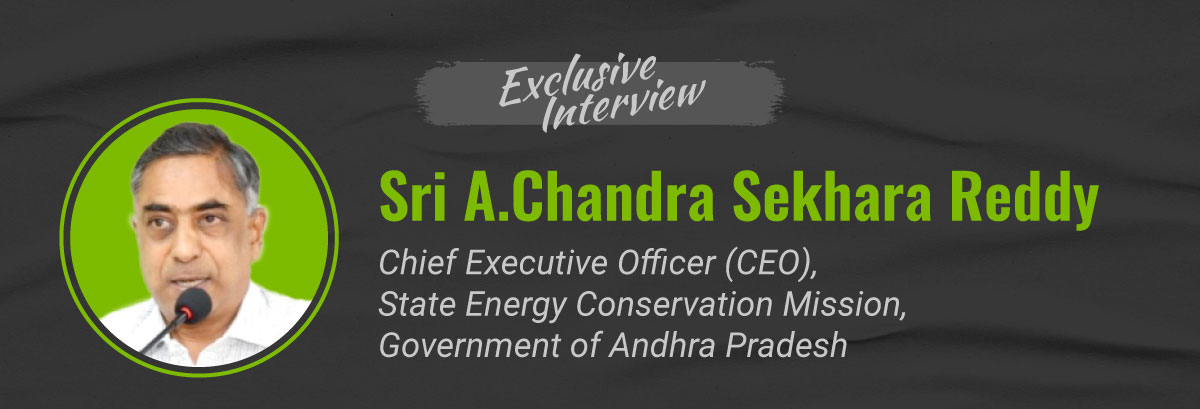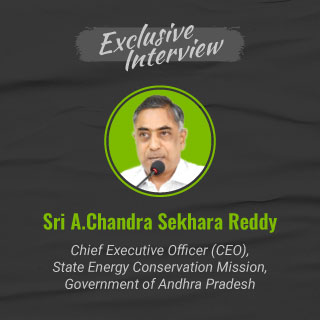
Andhra Pradesh State Energy Conservation Mission (APSECM) is at the helm of implementing energy efficiency activities in Andhra Pradesh. In recognition of these efforts, APSECM was conferred the first prize in the “State Designated Agency (Group-Il)” category at the Ministry of Power’s National Energy Conservation Awards held in December 2022.
In an exclusive interview with AEEE, Shri A. Chandra Sekhara Reddy, CEO, APSECM discussed the mandatory amendment and adoption of ECBC-2017 codes in building bye-laws, introduction of IOTs in MSMEs, electric vehicles and energy-efficient street lighting in municipalities and Gram Panchayats to ensure energy efficiency penetration in all sectors of the State. The interview also touches upon the importance of creating an enabling environment for sustained improvement in energy efficiency.
Q1. The process of forming a state-level steering committee for energy transition is in process in all the states. What is your perspective on the role of energy efficiency in energy transition at the state level?
Andhra Pradesh State Energy Conservation Mission (APSECM) is the country’s first standalone State Designated Agency (SDA) to implement energy efficiency activities in the state. An executive/steering committee and general body was constituted by the state government for APSECM, SDA. The Chief Secretary, Government of Andhra Pradesh (GoAP), is the designated Chairman of SECM and the Energy Secretary, GoAP, is the designated Vice- Chairman. A Chief Executive Officer who is also the member convener of SECM is appointed, with all secretaries of key government departments as the members of SECM.
Considering the role of energy efficiency in energy transition at the state level, energy efficiency is the cornerstone of the transition to a cleaner, more secure and sustainable energy future. It is fundamental to meeting climate action goals, strengthening energy security, improving access to energy and reducing local air pollution. Realising these potential efficiency gains would require a substantial shift in the balance of energy sector investment from the supply side to the demand side to meet the temperature goals of the Paris Agreement-2015. Energy efficiency can deliver 35% of the cumulative CO2 savings required by 2050.
As a steering committee, APSECM continuously monitors the overall progress of EE activities in the state and guides the energy transition by adopting new technologies. The state government of Andhra Pradesh has been aggressively implementing energy efficiency activities to achieve energy and economic savings and reduce greenhouse gas emissions. It is important to note that the Chief Secretary to the Government of Andhra Pradesh is heading the mission, serving as the Chairman of APSECM. This dual role ensures smooth movement of activities in the energy efficiency endeavour within the state.
The adoption of mandatory and stringent energy-related building codes for new residential and commercial buildings by the state and the extension of codes to existing buildings in the coming days is paving the way to improvements in building envelope performance. For example, adopting Energy Conservation Building Code (ECBC) is already mandated in the Andhra Pradesh building bye-laws.
Energy efficiency improvements in conventional engines are critical drivers of energy demand savings in transport. Electric cars are becoming more competitive as the incremental costs of additional efficiency improvements rise. AP has taken up the promotion of EVs and retrofitting of autos along with electrical buses in AP State Road Transport Corporation.
Adopting energy-efficient equipment like energy-efficient pumps and power quality control devices in urban local bodies (ULBs) and agriculture, among other sectors, has a significant scope of energy savings in the state of Andhra Pradesh.
In industry, a wide range of low-carbon technologies and processes needs be adopted at a faster pace and larger scale than before if the sector is to meet the ambitious goals set at COP26. The prestigious PAT Scheme of the Bureau of Energy Efficiency (BEE), Government of India, has paved the way for transforming large industries into more energy-efficient entities. Deepening of PAT helps to identify more designated consumers in the existing sectors, thus highlighting significant potential for energy-savings.
Apart from large industries, around 98,000 MSMEs in the state consume about 4,500 MU per annum, covering 19 sub-sectors. Adopting EE technologies and concepts like IOT etc would help tap considerable energy-saving potential in these MSMEs.
Q2. What are the three most impactful programs in place in your State in the energy efficiency domain across different sectors?
- Energy Conservation Building Code in the building sector: The Government issued G.O.Ms.No.180, making AP Energy Conservation Building Code (APECBC) mandatory for obtaining approvals for commercial and non-commercial buildings and upgraded AP Building rules as per the order. Andhra Pradesh is one of the first states to mandate amendment and adoption of ECBC-2017 to building bye-laws in the state. To date, around 60 awareness programs have been conducted involving architects, engineers and building professionals and 701 buildings have been declared ECBC-compliant as per Directorate of Town and Country Planning (DTCP) data.
- PAT scheme in industries: PAT Scheme has paved the way for transforming large industries into energy efficient entities. Around 52 large industries in state have saved about 1.204 million tonne of oil equivalent energy savings in the concluded cycles of PAT.
- Street lighting in Municipal and Gram Panchayats: Adopting revolutionary LED technology in street lighting achieved huge savings in villages and ULBs by changing conventional lights with LEDs. Around 130 Million units of energy in 106 urban local bodies and 156 MU in Gram Panchayats is saved.
- APSECM has introduced IOT in MSME as part of innovative technologies: IoT power monitoring devices were installed in 65 MSME units that helps to alert the MSME owner/entrepreneur. This helps to take corrective action against overloading and peak demand alerts, provides protection against equipment failure and aids in improving the power factor.
- One should appreciate the BEE’s sustained efforts to scale up energy efficiency programs from time to time by adopting several innovative measures in key sectors by encouraging the State Designated Agencies (SDAs).
Q3. Please share your State’s strategy to enhance energy efficiency adoption in the priority sectors in the near and medium term.
In order to enhance energy efficiency adoption in the priority sectors, the state is implementing the following activities covering various sectors:
- The state government has created energy conservation cells (EC cells) in all the government departments to tap the energy-saving potential available in the departments and their area of utilisation.
- The primary purpose of the energy conservation cell is to encourage efficient use of energy and ensure the reduction of energy consumption and electricity bills by effectively implementing energy conservation and energy efficiency activities so that the financial burden is reduced across the departments.
- The state is in the process of Adoption of Eco Niwas Samhita code for residential buildings to grab the opportunity of saving energy in the residential sector.
- Identifying new industries under PAT scheme is constantly carried out to cover more industries for adopting energy efficiency set targets.
- State Energy Efficiency Action Plan (SEEAP) is being framed sector-wise for implementation of energy efficiency measures.
- There is an upcoming dedicated energy efficiency policy for the State of Andhra Pradesh
- Awareness creation and capacity building on energy efficiency in MSMEs through workshops, seminars, demonstration projects, and sharing a common platform for interactions of FIs, OEMs (EE technologies), industries, ESCOs, and MSMEs.
- Taking up pilot projects for penetration of star-rated appliances to domestic consumers through various financing options
- Inculcating the concept of energy efficiency and adaptation among school children through energy clubs.
Q4. What opportunities and collaboration do you envision for cross-cutting energy efficiency adoption? What are the three topmost challenges in the economy-wide adoption of energy efficiency at the state level?
- Energy efficiency improvements can be achieved by reducing energy consumption and adopting technological changes. However, to sustain these technical improvements, it is important to create an enabling environment emphasising certain non-technical factors like better organisation, improved financial linkages and relationship building among multiple stakeholders.
- One of the barriers to the adoption of energy-efficient products is a lack of awareness. People generally are unaware of energy efficiency and savings to be incurred in the long run. The same applies to those who build or design commercial and residential buildings and do not know of the benefits of energy efficiency performance.
- Those aware of the long-term benefits and the larger vision behind adopting clean energy may face other challenges. They may not know how to go ahead, what the next steps are, where EE products are available, what the standards are to be used for comparability amongst the range of products if available, which the leading authorised agencies and distributors are, whom to seek advice from, through who and how to redesign the energy requirement for domestic or industrial or commercial purposes, what the key indicators for cost-effective efficiency improvements are and so on.
- While the sale of the EE products is taken care of, there may be a dearth of skills in proper installation and provision of after-sales services and repairs. The reasons may be many, it not being a priority for the decision makers, lack of endorsement for making energy efficiency improvements, lack of a larger vision behind promoting investments in energy efficiency and so on. On the other end, despite being aware and informed, consumers may not deem energy efficiency investments as the best use for their limited capital.
- Again, the high initial cost of energy efficiency investments often confines the popularity of these products and technologies to a particular class of consumers with high purchasing power. A consumer may consider repairing and continuing with inefficient appliances.
- Any initiative to promote renewable energy technology or energy-efficient products should first understand consumers’ needs, constraints, vulnerabilities and aspirations. They should be educated about the long-term benefits, informed about the back-and-forth linkages, provided with an easy-to-reach service network and offered multiple opportunities and choices to accomplish energy efficiency.
- Availability of information through authorised institutions or regulatory bodies to understand and evaluate energy efficiency investments is also crucial for credibility and sustainability. Broad sharing of experiences and analyses about costs and benefits, advantages and demerits of using energy efficient technology across all sections of consumers is also needed for providing an informed choice to consumer’s equipment for many more years, in lack of viable financial support.
- Companies often have misconceptions about the profitability of energy efficiency measures—taking risk indicators such as the payback period as a profitability indicator. Especially if energy intensity is low, improvements in energy efficiency might be underrated, possibly due to a lack of information to assess its value fully.
- Especially SMEs might be unable to reduce their uncertainties because of a lack of time and money to afford these transaction costs. Providing information first and then accompanying the steps of the implementation process of measures can lead to significant improvements in energy efficiency. These aspects should also be considered when suggesting energy efficiency measures (EEMs).
- The persistence of all these barriers is a critical justification for introducing policy instruments in the field of energy efficiency.
This interview was facilitated and compiled by Priyami Dutta and Meghaa Gangahar with inputs from Snehashis Tapadar, Sangeeta Mathew and Dr. Bhaskar Natarajan from Alliance for an Energy Efficient Economy.
